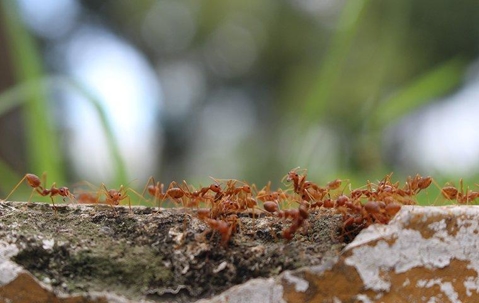Summer’s coming soon to Frisco, TX. Texas residents are ready for the warm summer sun, and with the warmest season upon us, it might feel like your skin is on fire. You might think it’s because of the heat, but there’s another culprit for a burning sensation on your skin: fire ants.
Named for both their fiery color and their burning bites, fire ants aren’t to be messed with. Let’s delve into identifying these irritating pests and what Frisco residents need to know about them.
Identifying Fire Ants
Fire ants are most identifiable by their reddish-brown color. There are two different types of fire ants – those native to Texas, and those that have been imported from other places in the world. Both look very similar to each other. Fire ants, like other ants, have six legs, sectioned bodies, and two bent antennae above their eyes. Fire ants grow between 1/16 and ¼ of an inch long. Their colonies create mounds that, when disturbed, can push fire ants to attack.
Can Fire Ants Hurt Me?
In short, yes. Fire ants are one of the most dangerous types of ants. They use a type of venom to subdue other organisms. These ants are highly territorial and will attack if they think their colony is being disturbed. Some fire ants only deliver a single bite, but non-native fire ants are more likely to bite their victims repeatedly.
Fire ant bites are often clustered together and they look like small, red bumps with lighter blisters on the top. These bumps are swollen, itchy, and painful, often lasting for about a week, though they may last longer if you continue to scratch and disturb the bites.
For many people, the only harm in fire ant bites comes in the form of these blisters. However, some people have an allergy to the fire ant that makes the bite more severe. You can be born with an allergy, or you can develop one. Many people who have been bitten by fire ants develop an allergy to the bites, over time, resulting in sudden and worsening symptoms. Allergic reactions to fire ant bites can include:
- Nausea
- Dizziness
- Difficulty swallowing
- Hives
- Anaphylaxis – includes headaches, chest tightening, low blood pressure, slurred speech, and loss of breath (rare)
- Seizures (very rare)
- Kidney failure (very rare)
The risk of a severe allergic reaction is small, but it’s still a good idea to avoid these bites, and see a medical professional if you develop any unusual symptoms or have concerns about fire ants.
Fire Ant Prevention Tips
To make problems worse, fire ants are notoriously impossible to get rid of on your own. If a fire ant colony gets into your yard and starts pushing into your house, it’s not just one problematic mound. Fire ants disperse and create separate colonies quickly, so if you see one mound or one source of fire ants, there are almost certainly other colonies scattered around your property. Getting rid of fire ants is like playing whack-a-mole: another mound always comes up.
The best way to get rid of fire ants is to prevent them from finding your home in the first place. Fire ants are attracted to properties with a lot of moisture. Also, it’s a lot easier for fire ants to create mounds in your yard or burrow under your home if there are piles of foliage, wood, straw, or mulch near your house or on your property. Finally, fire ants can get into your home if there are holes in your floorboards, A/C vents, utility lines, doors, and windows, only making the problem more severe.
Unfortunately, a house that’s conducive to fire ants may harbor fire ants for a while. Unless, that is, you contact the experts who know how to exterminate them. Reach out today to Adams Exterminating, and we’ll get you your yard back – and your home.

